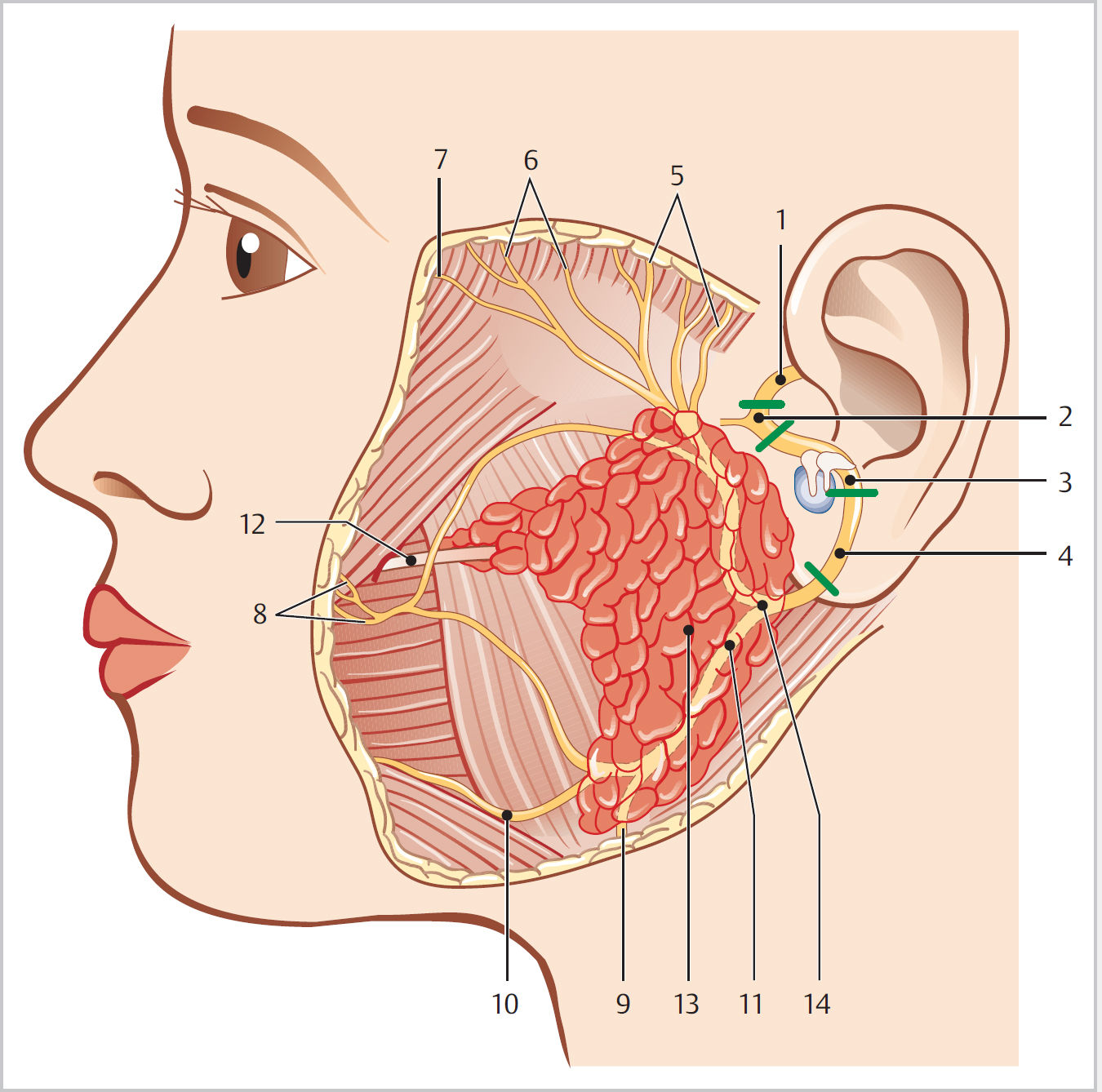19 Facial Nerve • Mixed cranial n: • Meatal, labyrinthine, tympanic, mastoid, extratemporal parts (Fig. 19.1) • Greater (superficial) petrosal: from geniculate ganglion, gets branch from tympanic plexus, enters middle cranial fossa, joined by deep petrosal (from sympathetic plexus of internal carotid); now termed vidian n (n of the pterygoid canal), passes through pterygoid canal to pterygopalatine ganglion; taste fibres pass on through to palate; secretomotor fibres synapse and pass on to lacrimal, nasal, and palatine glands • Nerve to stapedius • Chorda tympani: across middle ear between malleus and incus; leaves via petrotympanic fissure; joins with lingual nerve (of V n); parasympathetic fibres leave lingual to pass to submandibular ganglion, synapse, and supply submandibular and sublingual glands; majority of other fibres are for taste; projects to nucleus tractus solitarius • Post-auricular branch: to post-auricular m, post-intrinsic mm, and occipital m • Digastric branch: to posterior belly of digastric m • Stylohyoid branch: to stylohyoid m • Temporal: to frontalis, orbicularis oculi • Zygomatic: to orbicularis oris • Buccal: to buccinator • Marginal mandibular: to lower lip, chin • Cervical: to platysma • 1 cm inferior and deep to cartilaginous tragal pointer • Proximity to tympanomastoid fissure (sulcus) (~5 mm below fissure) Fig. 19.1 Anatomy of the course of the facial nerve. Intratemporal section: 1, meatal segment; 2, labyrinthine segment; 3, tympanic segment; 4, mastoid segment. Extratemporal section: 5, temporal rami; 6, zygomatic rami; 7, temporofacial portion; 8, buccal rami; 9, cervical rami; 10, marginal mandibular ramus; 11, cervical part; 14, extratemporal part. Other structures: 12, parotid duct; 13, parotid gland.
19.1 Anatomy (Fig. 19.1)
 Efferent motor fibres to muscles of facial expression, buccinator, stapedius, digastric (posterior belly), and stylohyoid
Efferent motor fibres to muscles of facial expression, buccinator, stapedius, digastric (posterior belly), and stylohyoid
 Afferent taste fibres to anterior two-third tongue and palate (chorda tympani)
Afferent taste fibres to anterior two-third tongue and palate (chorda tympani)
 Efferent secretomotor (preganglionic parasympathetics from superior salivary nucleus) fibres to lacrimal and nasal glands (via sphenopalatine ganglion), submandibular and sublingual salivary glands (via submandibular ganglion)
Efferent secretomotor (preganglionic parasympathetics from superior salivary nucleus) fibres to lacrimal and nasal glands (via sphenopalatine ganglion), submandibular and sublingual salivary glands (via submandibular ganglion)
 Afferent sensory fibres to part of concha ± area behind ear (passing with auricular branches of vagus: Arnold n)
Afferent sensory fibres to part of concha ± area behind ear (passing with auricular branches of vagus: Arnold n)
 Motor fibres from facial nucleus in pons, having received pyramidal fibres from motor cortex; most from contralateral side but those for forehead have bilateral cortical representation (hence forehead spared in upper motor neuron lesions)
Motor fibres from facial nucleus in pons, having received pyramidal fibres from motor cortex; most from contralateral side but those for forehead have bilateral cortical representation (hence forehead spared in upper motor neuron lesions)
 Sensory root enters brainstem as nervus intermedius
Sensory root enters brainstem as nervus intermedius
19.1.1 Course
 At internal auditory meatal fundus, motor root of VII n and nervus intermedius join; in cross-section, facial anterosuperior, cochlear n anteroinferior, vestibular nn post; Bill bar separates facial from superior vestibular, crista falciformis separates both of these from cochlear and inferior vestibular nn
At internal auditory meatal fundus, motor root of VII n and nervus intermedius join; in cross-section, facial anterosuperior, cochlear n anteroinferior, vestibular nn post; Bill bar separates facial from superior vestibular, crista falciformis separates both of these from cochlear and inferior vestibular nn
 Enters facial (fallopian) canal, narrowest segment of n course (labyrinthine)
Enters facial (fallopian) canal, narrowest segment of n course (labyrinthine)
 At medial wall of middle ear, turns at geniculate ganglion (1st genu) (processus cochleariformis is landmark); runs posteriorly with promontory below, lateral Scc above (nerve dehiscent in ~10% here)
At medial wall of middle ear, turns at geniculate ganglion (1st genu) (processus cochleariformis is landmark); runs posteriorly with promontory below, lateral Scc above (nerve dehiscent in ~10% here)
 After oval window turns inferiorly into descending mastoid part (2nd genu); short process of incus is lateral at this turn
After oval window turns inferiorly into descending mastoid part (2nd genu); short process of incus is lateral at this turn
 Descends posterior and deep to tympanic annulus, to emerge from stylomastoid foramen; posterior belly of digastric attaches to digastric groove, which leads forward to the foramen
Descends posterior and deep to tympanic annulus, to emerge from stylomastoid foramen; posterior belly of digastric attaches to digastric groove, which leads forward to the foramen
 Nerve turns forward to enter parotid, within which it branches to upper and lower divisions initially (at the pes anserinus)
Nerve turns forward to enter parotid, within which it branches to upper and lower divisions initially (at the pes anserinus)
 Note: n not protected by mastoid tip until 18/12 age
Note: n not protected by mastoid tip until 18/12 age
19.1.2 Branches
19.2 Surgical Anatomy: Facial N Identification during Surgery
Facial Nerve
Only gold members can continue reading. Log In or Register to continue

Full access? Get Clinical Tree



